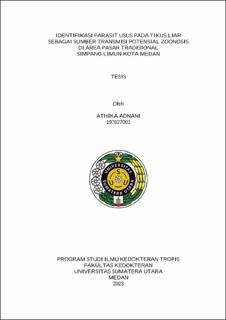| dc.description.abstract | Background: Rats are rodents that pose a threat to human life and play a significant role in transmitting infections as both vectors and hosts reservoirs of parasitic diseases in humans and animals, with potential zoonotic implications. Objective: To identify rat species based on morphology, the types of zoonotic parasitic worms and protozoa in the intestinal tract of wild rats, and prevalence of zoonotic intestinal parasites in the Simpang Limun traditional market area, Sudirejo II Village, Medan City, North Sumatera. Method: This study is a descriptive study with a cross sectional approach. The study population was wild rats by distributing a number of rat traps in the Simpang Limun Traditional Market area. The number of samples was 55 wild rats then continued the process of morphological identification and microscopic identification of parasites obtained. Results: The wild rat species found included Rattus tanezumi (90.9%) and Rattus norvegicus (9.1%). Parasite positivity was confirmed in 48 Rattus tanezumi and 5 Rattus norvegicus. Based on the results, 81.1% of trapped wild rats tested positive for at least one intestinal tract parasite. The parasite species identified were Nippostrongylus brasiliensis (65.5%), Entamoeba spp. (43.6%), Trichuris muris (32.7%), Moniliformis moniliformis (32.7%), Heligmosomoides polygyrus (25.5%), Isospora spp. (16.4%), Hymenolepis nana (14.5%), Cryptosporodium spp. (14.5%), Ascarids (10.9%), Cyclospora spp. (9.1%), Hymenolepis diminuta, Strongyloides ratti, and Syphacia muris 1.8% each. Conclusion: The most prevalent wild rat species is Rattus tanezumi. The species found was nine helminths species and four protozoas species. Among the zoonotic intestinal helminth parasite species identified were the Cestoda group, Hymenolepis nana with a prevalence of 14.5% and Hymenolepis diminuta with a prevalence of 1.8%. Meanwhile, the zoonotic intestinal protozoan parasites identified were Entamoeba spp. with a prevalence of 43.6%, followed by Cryptosporodium spp. with a prevalence of 14.5%. The presence of wild rats in the research area indicates the potential transmission of various zoonotic diseases to humans. | en_US |


